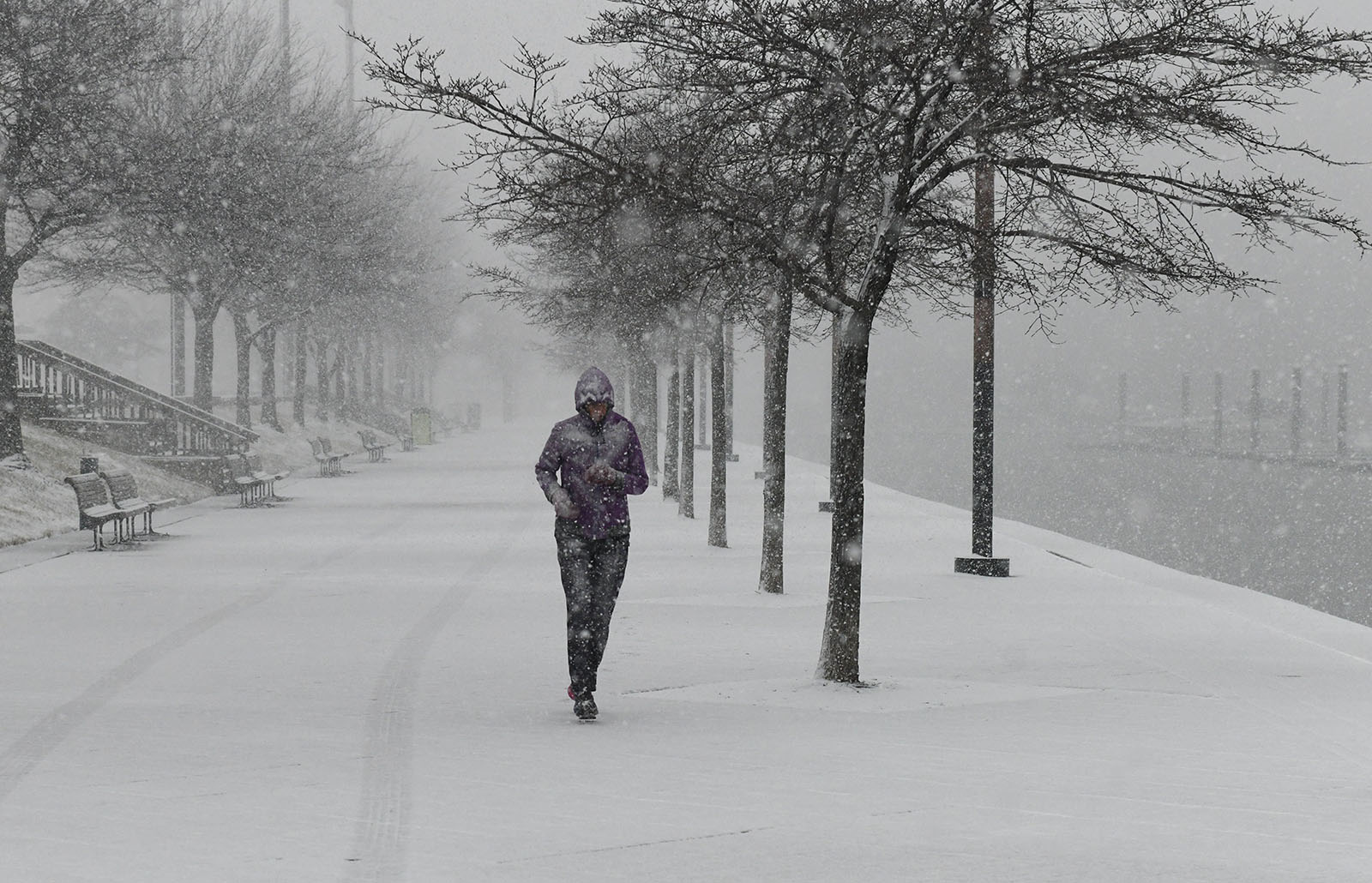
COLLEGE PARK, Maryland — It was March, the patient’s asthma was out of control and she knew why. “This weather is wreaking havoc with my disease,” the woman complained to her doctor, David Hill.
Hill wasn’t surprised. A member of the American Lung Association’s national board of directors, he knows that cold weather is broadly hazardous to public health in chillier parts of the country, including Maryland.
Most discussions about climate change and public health focus on heat. But scientists warn that extreme winter weather — cold snaps and storms — would pose a threat.
There’s extensive evidence that sustained exposure to extreme cold can cause harm by lowering body temperature, weakening the immune system and aggravating asthma, cardiovascular and lung disease, arthritis, diabetes and mental illness, among other problems.
Every winter, health officials warn of outdoor dangers for the homeless, who can freeze to death from hypothermia and snow shovelers who suffer heart attacks. Yet many more people are at risk indoors if their power has been shut off or they can’t afford to raise the thermostat. Research shows that for those with chronic disease a cold interior may be a dangerous environment.

Periods of frigid conditions make it difficult to stay healthy. (Jerry Jackson, The Baltimore Sun)
In Baltimore, some of the people most at risk live in low-income or majority black neighborhoods where certain chronic conditions affected by cold are most prevalent, a Capital News Service analysis of Maryland hospital records and U.S. Census data shows.
Many residents can’t afford to pay heating bills, according to BGE and state data, while others lack money to add insulation, repair or replace furnaces, or move out of decrepit rental housing where wind whistles through cracks around doors and windows.
Research into climate change is a rapidly evolving field with some studies challenging previous assumptions, including that heat is a bigger killer than cold. In fact, the opposite is true, according to a report from the Centers for Disease Control and Prevention in 2014. Of nearly 11,000 weather-related deaths reported nationally between 2006 and 2010, 63% were attributable to “excessive natural cold,” 31% to heat and the remainder to floods, lightning and storms.
The number of weather-related deaths may actually be larger, the CDC report said. It’s sometimes difficult to pinpoint a cause or a contributing factor. Someone with a history of chronic disease may be listed on a death certificate as having died of that, when in fact exposure to the cold made his condition fatally worse. Other times, death occurs weeks or months after exposure to cold triggered a decline in health.
One more factor, the report says, is whether the environment in which a person dies is taken into account: “If an elderly person dies at home and the home was under-heated, this contributing cause may not be noted.”
Baltimore residents cope with the cold. Photos by: Justin Marine, Wide Angle Youth Media (left), Jerry Jackson, The Baltimore Sun (right)
Elderly Face Higher Risks
Studies show that mortality rates for heat- and cold-related exposure are higher among the elderly, African Americans and men — more so in low-income areas.
In Maryland, since the winter of 2013-2014, there have been 208 cold-related deaths, including 51 this winter. The vast majority of those victims were not homeless, according to the state health department. 30% of them died in Baltimore, which is home to only about 10% of the state's population.
A year after the CDC’s report, another probed deeply into winter mortality data in the U.S. and France and debunked temperature as a primary cause. “The evidence suggests that cold plays a limited direct role,” the 2015 report said, identifying more important “seasonal factors” such as flu — an “important direct risk factor for winter mortality” partly because it’s especially dangerous for those with cardiovascular disease.
Even if cold isn’t a direct cause of many deaths, it exacerbates health problems that over the long run may contribute to premature death and diminished quality of life. In Baltimore, the neighborhood-level prevalence of some chronic health conditions rises and falls in tandem with familiar markers: variations in race, income, poverty and housing conditions.
A Capital News Service analysis of state hospital and emergency room records and U.S. Census data found that rates of respiratory conditions — such as asthma and COPD (chronic obstructive pulmonary disease) — and diabetes are generally higher in city ZIP codes that have a higher percentage of African-American residents. The rates of hypothermia, asthma and COPD are all generally higher in city ZIP codes that have higher poverty rates.
Where You Live Matters
Consider asthma, the health condition that fluctuated most closely in line with markers of race and poverty in the analysis.
In a swath of West Baltimore that borders Leakin Park (ZIP code 21216), 19 out of 20 residents are black, the highest concentration in the city. Between 2014 and 2018, 16% of inpatient hospital visits by people from that ZIP code featured an asthma diagnosis, CNS found.
In the most white area, ZIP code 21211, which includes the Hampden and Woodberry neighborhoods, the asthma rate was about half as large. About 9% of inpatient hospital visits by people from that ZIP code featured an asthma diagnosis.
The physiological reasons why cold undermines health are generally agreed on, if not perfectly understood. Older people and others with health problems may be less able to control their body temperatures. Veins and arteries constrict at lower temperatures, stressing the cardiovascular system. Brain function may be affected.
It’s clear there’s a strong connection between cold air and lung disease, Hill says. “Patients who have asthma or who have COPD on really cold days tend to have more wheezing and more shortness of breath.”
A CNS analysis of Baltimore city emergency response data illustrates this relationship. Between January 2014 and November 30, 2018, at times when the temperature fell below 10 degrees, 5.5% of all EMS calls were for asthma, compared to 2.8% when the temperature was 10 or above.
Why Cold Hurts
When it comes to arthritis, many who suffer from it see a connection to cold, yet studies conflict.
For most of her life, Katie Roberts, 42, an Arthritis Foundation advocacy chairwoman in Maryland, has lived with psoriatic arthritis, a chronic inflammatory disease that may initially cause red, flaky patches. She says she can feel when a winter weather storm is coming with 99% accuracy. Some research supports that, including a 2007 study suggesting that changes in barometric pressure as well as temperature “influence severity of knee pain.”
Outdoor temperatures also may affect people indirectly.
“If the weather's bad, people stay inside, and for arthritis, we know that, even when you hurt — even if it hurts to move — the movement is actually medicine,” said Guy Eakin, senior vice president of scientific strategy at the Arthritis Foundation. “If you're not getting out and getting that exercise, the bad weather could indirectly be causing you to experience some pain.”
On cold days, people with diabetes are also less likely to exercise, which research shows can help control weight and regulate blood sugar. On the other hand, insulin, glucose monitors and test strips will not work properly when exposed to cold temperatures and should be protected, Children’s Hospital of Philadelphia advises.
In 2018, Baltimore had 42 days when the temperature hit or dipped below freezing. Weather that cold not only discourages exercise but also keeps people from getting essential treatment.
“If you happen to be somebody that needs dialysis treatment three times a week and there's the extreme cold, where the roads are too icy, then you cannot go and get your dialysis treatment,” which can be life-threatening, said Amir Sapkota, associate professor at the Maryland Institute of Applied Environmental Health.
HOW COLD WEATHER AFFECTS HEALTH
Climate change is bringing hotter summers and an increase in global average temperatures. But deep winter cold snaps are unlikely to vanish in Baltimore — and could, in fact, become more common. That will mean continued problems for people with chronic medical conditions affected by cold weather.
By Aaron Wilson
Carbon monoxide exposure, a different kind of indoor hazard, peak in the winter, according to a federal research report, when people are more likely to use generators, stoves and home heating systems that may not be properly maintained.
When inhaled, carbon monoxide deprives the brain and heart of oxygen, causing headaches, fatigue and nausea. Severe cases of carbon monoxide poisoning can lead to long-term health problems and even death.
Fire is another winter home hazard. Fifteen percent of home fires involve heating equipment, almost all space heaters, according to the National Fire Prevention Association.
The list of diseases associated with cold exposure includes a category that initially might seem puzzling: mental illness. But prolonged cold spells can “create chronic stress situations” affecting psychological well being, according to a 2010 report from the National Institute of Environmental Health Sciences and the publication Environmental Health Perspectives.
People with steady incomes are generally better able than those of more modest means to fend off the effects of the cold. But that’s not always the case.
Charles Bright, 57, a social worker for The Recovery Center of Maryland, said he has diabetic neuropathy in both of his feet. In the cold, they go numb.
“I sometimes twist my ankles,” he said. “When I walk, I have to actually look down and make sure the pavement is there.”
Bright said his house is warm enough in the winter, and he doesn’t leave when he doesn’t have to. “Just the necessities,” he said.
Aaron Wilson and Ian Round contributed to this story.
Climate change in Maryland is not just about hotter summers. Despite the overall warming trend, expect periods of severe cold in the winter. Read the story.
At the heart of the issues of climate change and public health are residents trying to stay well in the cold. Read the story.
What are government agencies and institutions in Baltimore and Maryland doing to help people affected by the cold? Read the story.
Stay tuned. During the summer, Capital News Service, NPR and Wide Angle Youth Media will be reporting on the public health effects of climate change during hot weather. Follow the Climate and Health Project blog or sign up for our e-newsletter for details.